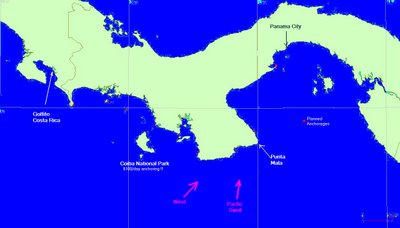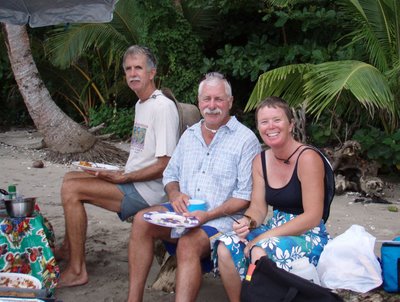After 2 more long days of motor sailing westward, we are finally in the area known as 'Western Panama'.
In the last blog post, we had just rounded Punta Mala. We actually turned the motor off and did some sailing that morning. However, soon after we finally shut the motor down, true to form, the wind went light and on our nose about an hour later, so we had to turn the motor back on. I think I need to add 'miles actually sailed without motor' to my monthly progress log!
As I keep telling Dave, we'd actually sail more if we weren't trying to go everywhere and do everything.
So picking up from yesterday's blog... the destination yesterday was Benao or Punta Guanico, about 10 miles apart just a little west of Punta Mala. Benao is open to the southwest, where both the wind and waves are coming from this time of year, so we weren't sure it would be a good anchorage. But friends had said you could tuck up way in and it's OK in mild weather.
We got to Benao about noon, and went in to have a look. Conditions were probably about as settled as you'd ever get during rainy season along that coast. Where the Bauhaus guide had an anchor didn't look that good... too exposed to the SW winds and southerly swell. But on the west end of the bay, there was a spot where one or two boats could anchor up and be a little more out of the wind/swell. (Approx 07-25.675N 80-12.205W) The bottom looked OK on the fish finder. But we did not stop. We wanted
to go a little further so our next day wasn't so long.
So we carried on to the Punta Guanico anchorage, about 10 miles further west. We stayed close in to sightsee along the coast. (watch out for fish buoys crossing the bay, but I think they are long lines, not nets).
Approaching the spot where both guide books said there was an anchorage, it didn't look very calm. But we crept in closer and motored up and down the coast a little, and found a fairly nice spot that seemed tranquil. (07-19.709N 80-20.773W) Since the tidal range is 'only' 10 feet here, we anchored in about 15' deep at mid tide. The bottom was very good holding.
We heard howler monkeys in the trees in the late afternoon. We could see the town further north in the bay, and hear music coming from a cantina (it was Saturday night), but weren't really interested in going in. A open fishing boat passed us in the early evening, going out to fish for the night. We saw 3 lights out near the point all night long, and they were still there when we left in the morning.
I found out later that the long low island to the north of our anchorage (Isla Cana) is home to one of the most prolific nesting grounds for the Ridley sea turtle, and it is nesting season. It would have been nice to have explored a little, but we are running out of time, and didn't want to lose this weather window to finish the most difficult part of the passage.
The next morning, we again got up at 5am and motored out and headed westward again. The Guanico anchorage had turned out to be very peaceful. But during dry season, with northerly winds, Benao might have been a better choice.
On our passage from Guanico around Punta Mariato we experienced the worst of the current-against-wind conditions that people told us to expect along this coast. We had a 1-2 knot following (westbound current) and light westerly winds and a large SW swell. The current made the waves very steep and close together. We buried the bow several times, even though the wind was only blowing about 5 knots. The worst part was the last 10 miles approaching Punta Mariato.
With the following current (and the motor on) we made very good time and rounded Punta Mariato around noon. Though our original plan was to head for Ensenada Naranjo for the night (#4 on our chart), we decided we had time to check out that anchorage and go all the way on to Isla Cebaco. So we stayed in close around the point, and went up through the slot between Isla Roncador and the mainland (in a heavy rain shower) and poked our nose into Naranjo. Again, it looked like, under the current conditions
(light SW winds and mild southerly swell), it would be an OK overnight stop. The swell does find its way in there, but gently so, and it looked like a good bottom for anchoring. Anchor spot approx 07-16.437N 80-55.510W
Then we carried on NW to Isla Cebaco, the SW corner, to an anchorage also called Ensenada Naranja (note that this Naranja ends in 'a' and the other one in 'o'). I did not number this one on our chartlet, but it is roughly due south of spot #5.
We had some decent sailing winds the last 2 hours, but since we'd decided to push on all the way to Cebaco, we had to keep the motor on to keep the speed up, so we could make the anchorage before dark. It looked like, in the SW conditions, that the traditional anchorage in the SE corner of the bay would be totally exposed, so we needed time to try to find a good anchoring spot.
We first went to the west side of the bay to look at what appeared to be on the chart, an anchorable spot with more protection. But it is not a designated anchoring spot in either guide book. And we agreed. It just looked too small to us, and maybe rocky on the bottom. Not near as anchorable as it appeared on the chart. It might be worth trying if you had more time to fool around.
So then went to where both guidebooks had the anchor, on the east side of the bay. We found some protection from the swell, but, as it appears on the chart, it is pretty much totally open to the southwest. We found about 6 moorings around the spot where the guidebook shows the anchor. Carina had told us that during the winter months, there is a fuel barge stationed in this part of the bay, and it's a popular stop for the sport fishing boats to get fuel and overnight on their way from Costa Rica
to Panama. Carina hadn't mentioned the moorings, though. But the fuel barge doesn't arrive until the winds change to a northerly quadrant, when the bay is well protected. Now, no barge, and all the moorings are empty--we were the only ones in the bay.
We poked around and found a bit of room shoreward of the moorings. The bottom is good sand and the anchor hooked up smartly. The light SW wind, blowing right into the cove, at least held us into the swell (until it dropped and went NW after dark). Since the wind dropped, we have been drifting around all night in essentially no wind, sometimes beam-on to the swell. But after the 3rd day of 'up a dawn, going all day', we were pretty exhausted, and slept pretty well in spite of the roll.
Our anchoring position is 07-29.528N 81-13.329W.
Note that on our Raster chart, this point shows as slightly inland. This chart is an old one, with WGS-72 as the datum. There may be a newer version of this chart that plots correctly, but be cautious.
Chart Name: M21582S0 - Bahia Montijo
Source Scale: 1:45000
Horizontal Datum: WGS-72
Just before dark, a Canadian boat named Tao 8 sailed into the anchorage and dropped nearby. We chatted with Larry for awhile, swapping experiences in anchorages. They are on their way from Golfito to Panama City.

